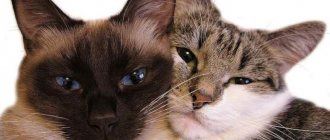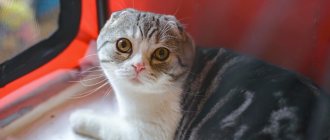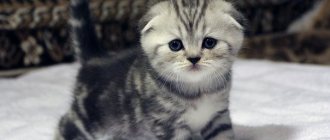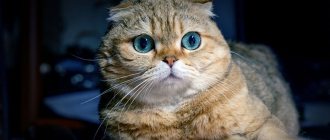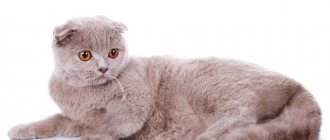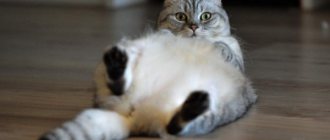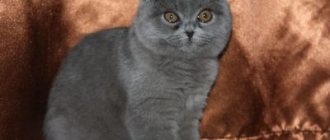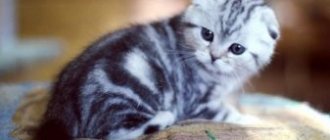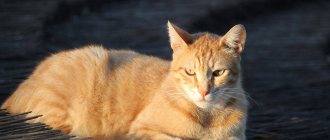British and Scots are considered one of the most popular breeds in the whole world, but many people confuse them with each other or do not see the differences at all. Even before the 2000s, crossbreeding of British Shorthair cats with Scottish Folds was carried out, which later gave rise to many misconceptions, for example, about the presence of British Fold cats.
In order to avoid becoming a victim of scammers involved in cat breeding, it is recommended that before purchasing a furry pet, you familiarize yourself with the external differences, the rules of caring for animals and the nuances that will help you understand how a British cat differs from a Scottish pet.
History of the origin of the British and Scottish breeds
It is believed that the first representatives of British cats lived on the islands of England. Due to isolation, they learned to survive in harsh climates thanks to their thick fur. In the 19th century, breeders were able to achieve even denser fur in these cats, and this is how the British Shorthair appeared.
The Scottish Fold cat appeared as a result of a gene mutation. The first cat with floppy ears was found on a farm, and her kitten was later crossed with a British cat. A couple of furry pets had five kittens - they became the ancestors of the Scottish.
There are several varieties of Scottish cats:
- Scottish fold. Differences include short hair and drooping or flattened ears.
- Scottish Straight. These are straight-eared, short-haired pets.
- Highland fold. Fold-eared long-haired.
- Highland Straight. The differences are long hair and straight ears.
In Scotland, lop-eared pets are not very popular, and many people are against breeding them due to health problems. They received recognition in the USA.
Video
* We invite you to watch a video about the Scottish Straight cat . In fact, in front of you is a playlist in which you can select and watch any of 20 videos about a given cat breed by simply clicking on the button in the upper right corner of the window. In addition, the material contains quite a lot of photos. By looking at them you can find out what a Scottish Straight cat looks like.
Rate the material!
[Total votes: 6 Average: 4.5]
The Scottish Straight cat has gained enormous popularity in just half a century. These affectionate, inquisitive and good-natured cats easily get along in a variety of families. They do not require serious care and special educational methods: Scottish Straight cats are smart and easy to train.
Breeding Features
There is a big difference between breeding British and Scottish cats. For example, mating between Scottish dogs of the same species is prohibited due to the high risk of giving birth to sick kittens with disorders in the skeletal system.
To avoid the appearance of ugly and weak offspring, crossing is carried out between folds and straights. From such mating, both fold-eared and straight-eared pets are born, which are eventually confused with British cats.
In the 80s, it was popular to mix the British with the Scots, which led to a decrease in differences and the following negative consequences:
the muzzle of British cats has become smaller, the body, on the contrary, has elongated, and the coat has become coarser; representatives of the Scottish species have lost their gracefulness, and they have a large number of health problems.
Interesting! After crossing a British female with a Scottish Fold, a British Fold kitten was born, which was classified as a Scottish-British breed, but it did not receive recognition in the world. The main external difference is that the animals had large ears that were not adjacent to the head.
Today there are no British Fold cats, since mating between Scottish and British breeds has been prohibited since 2004.
Caring for Scottish Straight Cats
Scottish Straight cats do not require serious care like, for example, Sphynx or Persian cats. The minimum hygiene procedure is combing the coat, which should be done two to three times a week. When shedding cats should be brushed every day. This will prevent the fur from getting tangled, and the pet will not lick off the fallen fur.
Scottish Straights can also be given a special paste that promotes the rapid release of hair from the body. There is no need to wash Scottish Straights often - about once a month will be enough. Cats are good at cleaning themselves.
Important fact: It is necessary to keep the Scottish Straight ears clean. They can be cleaned once a week with cotton swabs and lubricated with a special ointment. The eyes should also be clean and healthy, without tear discharge. If there is discharge, you need to take the cat to the veterinarian.
Scottish Straights have their nails trimmed, but only the transparent part needs to be cut off. To trim claws, you should only use a special nail clipper, which will not damage the structure of the Scottish Straight claw. After cutting, it is best to treat your cat's claws with hydrogen peroxide. It is worth trimming no more than once a week - it is best to observe when the claws stop retracting into the pads of the fingers.
The Scottish Straight cat needs regular examination by veterinarians, who will examine the general condition of the animal and the condition of its teeth. It is necessary to have regular vaccinations, which will be recorded in the cat's passport. Once every six months, cats are treated for parasites.
It is worth remembering that cats of this breed are big sleepyheads, so make sure that the cat has a comfortable bed or house. There the cat must feel safe, otherwise the animal risks getting sleep deprivation and, therefore, stress.
External differences
There are several visible differences between British cats and pets of Scottish blood.
| External characteristics | British | Scots |
| Ears | Wide set and straight. | Straights are straight, but more tapered and closely spaced than the British. They have softer ear cartilages to the touch. Folds have flattened and curled ears of small size. |
| Head | Large, round in shape and with a pronounced chin. The muzzle has a serious expression. | Round in shape, but smaller in size. You can read tenderness on the face. |
| Eyes | Round, large and widely spaced. | Round, but smaller. |
| Cheeks | Short hair creates a visual illusion, as if the pet's cheeks are touching the shoulders. | Small cheeks. |
| Nose | Straight and wide. | More elongated shape. |
| Legs | Shortish, with powerful pads. | Long, making the animal look taller. |
| Tail | Thick, not very long and with a rounded tip. | Long, tapering towards the end and more mobile. |
| Wool | Thick and plush. | Less dense and silky. |
| Weight | From 4 to 9 kilograms. | From 3 to 6 kilograms. |
| Skeleton | Stocky body with a pronounced chest and a short, faintly visible neck. | The body is medium in size and has an elongated shape. |
In addition to the differences, there are a number of similarities between the British and Scottish breeds: round eyes, pronounced whisker pads and a rounded head.
Description of Scottish Straight
Scots are very similar to British Shorthairs. By the way, fans often confuse them. This is no wonder: the British are the ancestors of Scottish cats. However, there are still noticeable differences between the breeds.
What is the difference between a Scottish Straight and a British Shorthair cat?
Scots weigh less than Britons. They are more flexible, slender and graceful than British cats. The head has a more rounded shape than its ancestors.
In general, breed standards are very similar.
Scottish Straight breed standard
The head is round, with soft features. The neck is short and muscular. The chin is powerful, the cheeks are large and plump. The forehead is high and prominent. The nose is wide, with a small depression at eye level, black.
The erect ears of the Scots are their only difference from the Scottish Fold breed. The ears are small: either medium-sized, or small and neat. They are set high on the head and far apart from each other. The ends of the ears are softly rounded. Scots have large and round eyes. They are set wide on the face. The color of the iris can be any, but a prerequisite is a correlation with the color of the coat. These are medium sized cats. The body is slightly elongated, but muscular, plastic and flexible. Adult males weigh no more than 5 kg, and females - 3-3.5 kg.
The legs are of medium length, strong and proportional to the body. The tail is very long, not wide, with a noticeable narrowing from the base to the end.
Scottish Straight color
The Scots' coat is plush, soft and thick. Thanks to the dense and pronounced undercoat, even short-haired Straits look fluffy. The breed standard allows both long-haired and short-haired Straights. Long-haired individuals have medium-length fur. The muzzle and paws have the shortest hairs, but the neck and tail have the longest. Males boast luxurious manes and impressive plumes. There are a great many color options. Both single-color and two-color cats are equally common. The most common colors:
- Solid (solid: white, black, lilac, cream, red, red, gray, blue)
- Brown and its shades (chocolate, fawn, cinnamon)
- Smoky, silver, golden
- Bicolor (two-color color, the second shade is white)
- Tortoiseshell (tri-color)
- Marble
- Tabby (striped and ticked, that is, the hair is darker at the tips than at the base)
- Color point (Siamese colors: seal point and blue point)
- Mackerel (brindle color)
- Harlequin (the main color is white, with spots of a different shade on it)
- Chinchilla (silver-blue color).
The most expensive are the lilac-colored Scots, as this is the rarest color of the Scottish.
Scottish Straight size
These are small pussies, they are plump and muscular, but at the same time graceful and sophisticated.
Males are much larger than females. The maximum weight of males is 7 kg, and females - 5 kg, but more often they are slightly smaller, in the range of 4-5 kg.
Scots are born very young. By the age of one month, Scottish girls weigh from 300 to 600 g, and boys - from 450 to 700 g. By the age of two months, kittens double their weight. The main growth of cats continues until 10 months, then from 10 months to two years, Scottish cats only slightly gain weight.
Scottish Straight character
The Scots differ in their character from their close relatives, the British. As you know, British Shorthair cats have a cool temperament. But Scottish Straights are peace-loving and kind animals, docile and soft.
They are calm and sociable. Restrained and well-mannered animals avoid conflicts. They are affectionate towards all family members, but usually choose one person who is most pleasant to them. It is this person that the cat will consider its owner.
They are obedient and lazy. They don't tolerate fuss. They do not misbehave or misbehave, although they are not averse to playing and frolicking. Cats have a developed sense of proportion.
Scots love affection, but they will not tolerate excessive cuddling.
These are very intelligent animals, they are smart and quick-witted. They are easy to teach to follow simple commands. They are no strangers to training. Sometimes it seems that the Scottish Straight understands human speech as if it were his own.
They don’t spoil the renovation, don’t sharpen their claws on the sofa and don’t tear the wallpaper. Intelligent pets!
A straight-eared kitten will calmly survive forced separation from a person. You shouldn’t subject your cat to such a test too often, but even if you are away from home for some time, you don’t have to worry about your furry pet.
The lazy Scottish Straight does not like noise and din, but the arrival of guests and a cheerful feast will not shock him. Thanks to their sociability and curiosity, Scots are drawn even to strangers.
Scottish Straight health
Scottish Straights are strong and healthy domestic animals. No serious genetic diseases were observed in them.
The only disease peculiar to the Scots is hypertrophic cardiomyopathy. This heart disease is incurable, but with early diagnosis it is possible to stop the rapid development of the disease and the deterioration of the cat’s condition.
Main symptoms of cardiomyopathy:
- Depression
- Loss of appetite
- Tremor of limbs
- Loss of consciousness.
Like other cats, Scottish Straights are not immune to cat parasites. Both fleas and worms are a scourge common to all cats, both purebred and ordinary.
With adequate care, Scots live a long time: from 14 to 18 years.
Differences in Personality
The main differences between the character of a Briton and a Scot:
- British cats are less assertive and have a softer temperament;
- The Scots love to play and communicate with people more, while the British spend most of their time alone;
- Scottish cats easily get along with other animals in a short time, British cats treat them with condescension.
Interesting! Scots love to stand on their hind legs and can spend a lot of time in this position, watching with curiosity what is happening around them.
Representatives of these breeds have few differences in character traits:
- they are friendly, but do not like to be held;
- clean;
- love to be surrounded by people, but show devotion to only one owner;
- easy to train;
- have developed hunting instincts;
- do not show aggression towards children.
Note! Each animal has its own character, so visible differences can appear even among representatives of the same breed.
Buy Scottish Straight
Scots are widespread both abroad and in Russia and the CIS countries. Many breeders are engaged in breeding the breed; specialized Scottish catteries are not uncommon.
You can easily find a Scottish kitten on private message boards (for example, on Avito or Yula). But experts advise buying not from private individuals, but from official nurseries. Animals from breeders are more expensive, but they come with a guarantee and a full package of documents.
The minimum cost of a Scot is 9 thousand rubles. The price varies depending on the pedigree and color of the animal. The most expensive and valuable are lilac and marbled kittens (marble stripes on a gold or silver tone). Such cats cost up to 50 thousand rubles.
Who is better to give preference to?
When choosing a pet, it is important to consider its temperament and character. British cats are more suitable for people who are willing to tolerate the freedom-loving nature of a cat. Scots will fit perfectly into a family with children or other pets.
All the described differences and features will help to correctly identify a Scotsman or a Briton, however, to be completely sure, it is recommended to seek help from a felinologist. And don’t forget: a pet will become a member of your family, so purchasing it should be approached with the utmost responsibility.
Did you like the article?
Diseases and health problems
Scottish Straights often suffer from watery eyes, so you should pay special attention to the health of these cats' eyes. This is due to the special structure of the skull, in which the lacrimal glands of these cats are greatly narrowed. You need to be wary if your eyes have yellow or purulent discharge. Sometimes wet eyes are evidence of reduced immunity.
The ears are also a vulnerable area for Scottish Straights. If your Scottish Straight often shakes its ears, scratches them, or becomes irritated at the slightest touch to its ears, then you should take the animal to the veterinarian. The cat probably acquired otitis media, ear mites or fungal diseases. Sometimes this happens due to the accumulation of earwax.
Osteochondrodysplasia is typical for this breed, although Scottish Folds are more often affected. With this disease, cats limp and walk on bent legs. Leg deformities occur slowly, gradually making running and jumping more difficult.
Interesting fact: Scottish Straights are prone to hair loss, but this is more common in pregnant and lactating cats. As a rule, baldness is prevented by vitamins.
Urolithiasis is also typical for the breed - it usually affects neutered adult cats or overweight animals. The problem is solved by changing the food, since often it is simply not of sufficient quality. Sometimes veterinarians recommend giving cats vitamin A. Urolithiasis can be caused by infection or hormonal imbalance. There is blood in the urine of animals suffering from this disease.
Scottish Straights are prone to obesity. The cat's ribs should be palpable, but if only fat is felt, then the cat has weight problems. It is worth controlling the amount of food your animal eats.
Prices
Prices for British kittens, for example, in Moscow range from 85 to 850 dollars .
In Perm you can buy a British one second-hand for less than a dollar , or they’ll even give it away for nothing. But these, of course, are kittens for the soul, without documents or guarantees.
The price for kittens with a confirmed breed varies from 20 to 500 dollars .
The cost of a fluffy miracle depends on veterinary documents, the kitten itself and pedigree.
“Rejected” kittens are the cheapest. “Purebloods” are the most expensive.
Purebred kittens are divided into three classes - “pet”, “breed” and “show”. Each class has its own price.
Pet-class kittens cost from $400 , breed-class - 600 , show - 800 and more .
Have you chosen? See how to name a British kitten →
How to distinguish a fold-eared kitten
Only after two weeks is it possible to distinguish them in the litter. At this time, in babies with straight ears, the ear cartilage begins to harden. This does not happen with folds; they have folds, which are their distinctive feature.
The main rules for choosing a fold-eared kitten:
- The older the baby, the easier it is to evaluate his external qualities. This is especially important if the cat is selected for breeding. It is better to choose an individual that is at least three months old.
- A true “Scotsman” should have a cheeky muzzle and wide-set eyes. Folds often have a wide chest, a thick, short tail and massive paws.
- To avoid an obvious defect, you must definitely feel your nose for the presence of a hump. It shouldn't exist. You should carefully feel the tail; there should be no knots or humps on it.
- The kitten must be completely healthy. Its fur is silky and thick. The eyes are clear, the belly is soft, and the mood is playful.
- If an animal is purchased for breeding or to participate in exhibitions, then it must have a pedigree and a veterinary passport.
- It is better to choose a kitten in the cool season. In extreme heat, there are times when Folds' ears rise slightly. This is not a defect, but an interesting feature of the breed.
- You should not save when choosing an animal. Real thoroughbred “Scots” are not cheap. If the breeder provides a large discount, it is worth considering that the kitten is a reject.
Choosing a purebred Fold with good breeding qualities is a difficult task, but it can be done. How to determine whether a kitten is lop-eared or not is described in detail above, but do not forget that cats are very picky, stubborn and capricious. You need to choose an animal not only based on external data. There is an opinion among animal owners: “We don’t choose them, but they choose us.” If the relationship does not work out from the first moment, then no matter how beautiful the cat is, it is better to take another one. Otherwise, life together can turn into a protracted war, in which it is absolutely unknown who will win whom.
When choosing an animal, at a minimum, it should not hiss or growl at its future owner. And if the cat sits in your arms and purrs sweetly, then this animal is definitely yours! This means that he recognized his future owner as a kindred spirit. And life with such a baby will sparkle with all the colors of the rainbow. Such a cat will really brighten up the life of its beloved owner!
Among the cat breeds recognized by international felinological organizations, only Scottish Folds and Highland Folds are fold-eared, that is, Scottish shorthaired and semi-longhaired fold cats. That is, the ears of Scottish Fold cats are considered a feature that is not repeated in any other breed.
We clarified about recognition by felinologists, because There are also outbred fold-eared cats, which are obtained as a result of random genetic mutations, but no one further fixes this gene and breeds a new breed. It only occurred to a breeder from Scotland to do something like this in the mid-20th century.
When properly crossed, the gene for lop ears
inherited from one of the parents. It is dominant, that is, if it is included in the cat’s genetic makeup, it should appear visually. However, there are nuances.
How to determine if a kitten has lop ears?
Many people ask how to determine whether a newborn kitten is lop-eared. In a newborn it is not visible at all. Look at the photo above: do you see anything at all in it, except for the color (which, by the way, also does not take time to be fully formed right away)? But from the 18th day it is already clear what kind of ears the kitten will have - straight or curved. Then you will see that some kittens’ ears have fallen a little forward and down and there are folds.
When kittens develop lop ears, it is already clearly visible that their ears droop with one, two or three folds. If there is only one fold, then most likely, with age, the ears will rise completely or rise. If there are two folds, then depending on your luck: they can rise only a little, or they can rise a lot and become so-called helicopters. The treasured three folds are very rare: such ears will lie perfectly throughout your life.
So, the signs of lop ears in a kitten are as follows: curved down and forward + folds + smaller size. There are no other signs, such as the color of the fur on the ears, etc. degrees
Baby development
Newborn British kittens are very attached to their mother cat. They are helpless and practically do not move. Within 1-2 weeks after birth, their eyes open. You can raise a healthy baby and ensure its harmonious development without rushing to tear them away from mother's milk.
British babies are born without teeth, they gradually come out by the month. And from the age of 3 to eight months, their teeth will be replaced with permanent ones.
Growing up happens very quickly; at 4.5 months the cat already becomes a teenager. By the age of five months, British eyes change color. You can accurately determine the age of an animal if you have some experience in this; it is better to ask the breeder or look in the documents.
